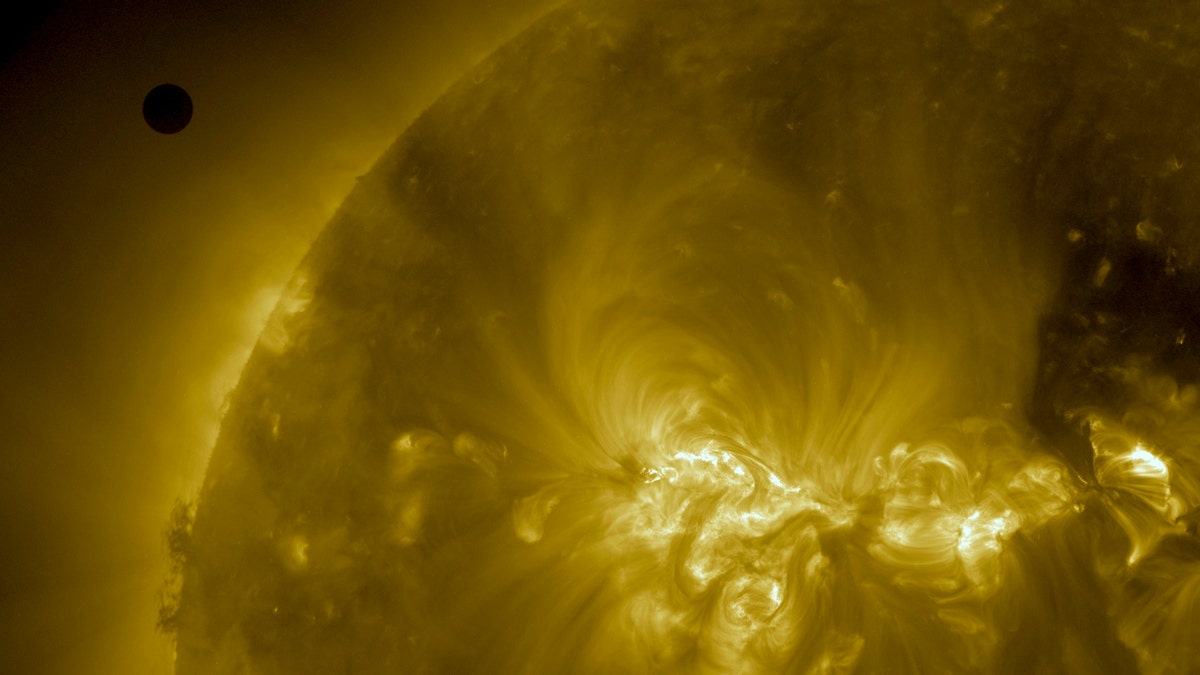
Handout image courtesy of NASA shows the planet Venus shortly before its transit of the Sun, June 5, 2012. (REUTERS/NASA/AIA/Solar Dynamics Observatory/Handout)
Just like out of a “Star Wars” movie, NASA is investigating the possibility of building a blimp-suspended city in the clouds high above Venus' searing-hot surface. The project, known as the High Altitude Venus Operational Concept (HAVOC), is a spacecraft designed by the Systems Analysis and Concepts Directorate at NASA Langley Research Center for the purpose of exploring Earth’s closest neighbor. “There’ve been plenty of robotic missions along the way that have been proposed to explore Venus,” Project Head Dale Arney told FoxNews.com. “This one [is] looking at what it would take to explore it with humans and what the feasibility looks like in that realm.”
Despite Venus being closer to Earth than Mars by a few hundred million miles (depending on orbit), space agencies have been focusing their exploration efforts primarily on the red planet, and for good reason. While Venus has a similar density and chemical composition to Earth, the surface conditions have led researchers to refer to the planet as the solar system’s version of Hell. The mean temperature is a balmy 863 degrees Fahrenheit, the clouds are made of sulfuric acid, and there are more volcanoes (totaling, in some estimates, over 1,000,000) than on any other planet in the Milky Way. The air pressure is also 92% percent higher than Earth’s at sea level. Probes landing on the planet’s surface have only lasted, at most, two hours.
The HAVOC project, created by Arney and Chris Jones, would get around this problem by staying high above these hellish conditions -- 30 miles above the surface, to be exact. First, a robotic probe would be sent to Venus to inspect the atmospheric conditions. Next, a crew would visit the planet’s orbit for a stay of 30 days, followed by a 30-day stay floating in the atmosphere. The primary feature of the concept is a 130 meter-long mobile blimp, its top covered with solar panels to utilize Venus’ close proximity to the sun. The helium-filled, solar-powered craft would hover above the highly acidic cloud-line for 30 days as a crew gathers information about the planet’s atmosphere.
While a permanent human presence in a blimp-suspended “cloud city” is the ultimate goal, Jones is quick to point out that they’re taking things one step at a time. “What we focused on in this study was understanding what an initial robotic and an initial, very short-term human mission would look like, and then just very notionally thought about what you could then build to beyond that -- something like a more permanent presence. But our primary focus was on understanding what kind of technology system it would take to do any kind of mission at all, mainly to do the science and test out the technology it would need in order to enable those kinds of missions.”
A mission to Venus could be used as a test-run for crewed missions to Mars, the former taking 440 days using existing or near-term propulsion technology while a trip to the red planet would take 500 days at a minimum. Astronaut teams would also have the choice to abort a Venus mission and return to Earth immediately after arrival, whereas missions to Mars would have no such option: the crew would have to wait on the planet until just the right orbital alignment occurred for a safe return home.
So when can we expect to see an actual mission? NASA currently has no plans to send humans to Venus and according to the Langley branch’s head of public affairs Michael Finneran it may be a while before they do. “This is a visionary concept that is not being proposed for funding as a mission,” Finneran says. “If at some point NASA decided to fund a human mission to Venus, many concepts would be examined over a period of time before one was selected.”
